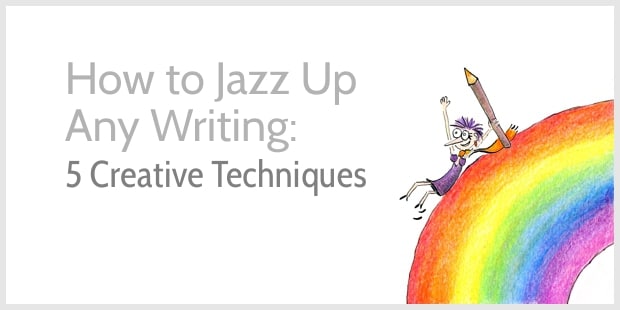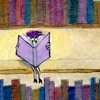 A weird idea exists in the world of writing.
A weird idea exists in the world of writing.
When writers talk about creative writing, they only refer to fiction.
As if non-fiction can’t be creative …
What a crazy idea.
Of course, non-fiction can be creative. Any creative writing technique can be used to improve any kind of writing.
Shall I show you?
Creative writing examples in non-fiction
When reading non-fiction, I often find myself speeding up. I try to grasp ideas quickly, and I do not pay much attention to words and sentences.
The ideas feel worthy of my time, the writing not.
I’m currently read Fathoms by Rebecca Giggs. It’s a book about whales, and the relationship humans have with whales. It’s half science, half philosophy. You may think that’s a recipe for boring writing.
But no …
I find myself slowing down, paying attention, savoring the words like a good wine. This is especially true for the first chapter.
What makes Giggs’ writing so enjoyable?
She knows how to captivate her readers; she knows how to choose words; and she’s added a large dollop of creativity to her writing.
Let me show you …
1. Zoom in
In her first chapter of Fathoms, Giggs describes how whales remain part of the ecosystem after they die.
But she starts by zooming into the story of one specific whale—a beached humpback whale:
I put one hand briefly on the skin of the humpback and felt its distant heartbeat, an electrical throbbing like a refrigerated truck, sealed tight. I wanted to tap on the outside of the animal and whisper to it: Are you in there, whale? Neighbour, is that you? Life on that scale — mammalian life on that scale — so unfamiliar and familiar in turns. Oh, the alien whale. The world-bound whale. A stranger inside. I hated to watch it.
Non-fiction writing is often abstract. We want to explain trends or general tips. But such writing is hard to grasp and easy to forget.
So, the trick to writing engaging non-fiction is to zoom into specific stories that illustrate your points.
For instance, when writing a blog post with tips, share a story—real or imagined—of someone who implemented those tips. On a sales page, a testimonial can take the shape of a miniature story demonstrating how a product or service has changed one person’s life.
Stories belong everywhere, in fiction and non-fiction.
How to weave stories into your writing: The Zoom-In-Zoom-Out technique >>
2. Paint vivid imagery
Giggs paints vivid imagery, making me feel like I’m looking over her shoulder:
The whale was black like piano wood, and, because it was still young, it was pink in the joints under its fins. Waves burst behind it, sending spray over its back. Every few minutes, the whale slammed its flukes against the wet sand and exhaled loudly — a tantrum or leverage. Its soft chest turned slack, concertinaed by the pull of the swell.
Can you picture the beached whale and hear it exhaling?
Vivid writing makes readers feel like they’re present in the story. Readers look through the author’s eyes, seeing what the author sees. They listen with the author’s ears, hearing what the author hears.
Readers experience stories and that’s what makes stories memorable.
In non-fiction writing, you have several opportunities for painting vivid imagery. First, on a sales page, let readers imagine what it’s like to use your product or to work with you. How will you improve their lives? How will that make them feel?
Secondly, make testimonials more like real life. Ask clients to describe in more detail what it was like to work with you. What specifically did they enjoy? And how has your service changed their lives?
Lastly, tell your own stories. For instance, on an about page or in a blog post, explain why you do what you do. What drives you? What makes your heart sing?
Use the 8 life forces to let readers imagine a better life >>
How to write powerful testimonials: Templates + examples >>
How to write an inspirational business story >>
3. Hook readers
Straight from the first sentence in Fathoms, Giggs hooks her readers.
Here’s how her book starts:
A few years ago, I helped push a beached humpback whale back out into the sea, only to witness it return and expire under its own weight on the shoreline.
That sentence makes me want to learn more. Why did the humpback whale return? How did it expire under its own weight?!!???
I read on to the second sentence, which is even more intriguing:
For the three days that it died, the whale was a public attraction.
So much drama is in that one sentence. How could it take the whale 3 days to die? And how could that be a public attraction? There’s so much tension in the contrast between dying and being an attraction.
You may think your task as a writer is to explain, to educate, to inspire, or to sell. But if you don’t hook your readers first, you won’t get an opportunity to share your ideas or to communicate your sales pitch.
How to hook your readers >>
4. Show and tell
The official advice in creative writing is to “show, don’t tell.”
But in practice, we often show AND tell.
Telling means giving a brief, factual statement. Showing means using sensory details and describing actions to direct a mental movie in your reader’s mind.
For instance, here’s how Giggs tells us how oceans were feared in the past:
People once feared there was a terrible, existential emptiness in the ocean, an unpeopled and unending openness.
It’s an example of telling because we can’t visualize it. It’s simply a statement of people’s existential fear of the emptiness in the ocean.
Here’s how Giggs finds a way to show this is true:
In antiquity, cartographers populated the seaward frontiers of their maps with drolleries. Hand-drawn pictograms, drolleries are whales hybridised with sea serpents; monsters adorned with antlers and tusks, scales and sprigs of feathers.
Showing requires a writer’s ingenuity to find an example that can demonstrate that a statement is true. It not only increases credibility, but also makes the writing more interesting.
So, each time you make a generic or abstract statement, ask yourself: How can I demonstrate this is true? Can I share an example or two?
18 show don’t tell examples >>
5. Play with your words
The usual writing advice is to use the words everyone else is using, right?
Yes, plain language helps make your writing easy to read.
But your writing doesn’t need to sound like everyone else. You can add a little flourish here or there to let your personality shine through.
For instance, Giggs uses sensory language to help us imagine what it’s like to hear a whale breathe:
Stood ankle-deep on the beach at night, you hear them. That is, you hear the whales breathing. How the sound carries across the water, I do not know. A whale sneezes: you jump. It sounds like a roller-door slamming.
And note the strong verbs Giggs uses to describe the sociable noises that humpback whales make:
The whales grunt, rasp, thwop, and moan; they shriek, whine, bubble, gurgle, and fin-slap on the sea’s topside, as well as generating what are called ‘pulse trains’: subsonic resonances, only recently discovered, that thump across the lower thresholds of human hearing like rain drubbing a tarp.
The words you choose help create your writing voice so readers can recognize your writing and look forward to hearing from you again.
So, when you’ve finished a blog post or a sales page, look for two or three important sentences, and then play with the words. How can you make your words more powerful?
Imagine your reader …
It’s Monday morning 8 A.M.
She feels tired, a slight headache. The weekend was far too short.
She switches on her computer and checks her inbox, while sipping green tea.
There’s your email …
Will she click away, uninterested in more dry advice?
Or is there a story to engage her?
Are her eyes lighting up because she’s delighted to hear from you?
Book mentioned in this post:
- Fathoms: The World in the Whale by Rebecca Giggs


Another fabulous writing course within a post Henneke.
Every time a whale dies on a beach, it is such a sad event. However, even in death they provide us with the opportunity to practice our story telling, engaging emotions that add so much to the reading experience.
Thank you.
PS. The list of links are a very generous bonus!
Thank you, Barry. I sometimes surprise myself how much I’ve shared on this site already!
Awesome article.
It was delightful to read the blog post,
Thank you, Mariella. I’m glad you enjoyed it!
Hi Henneke. I really enjoy your blog posts. They are both engaging and comforting. You transmit a sense of calm and peace. Thank you.
That’s such lovely feedback. Thank you, Marta.
I have to say, “concertinaed” is an inventive word. Took me a couple of moments to get the full meaning there, but they were fun moments. “Drubbing” I had to look up, haha. But I can’t wait to use it in a story, now.
I attempt using such writing in my stories. I also try keeping it short, interspersed with a long sentence, now and then, providing variation.
Thanks for much-needed reminders that non-fiction writers need ot study fiction and use the genre’s best devices! 🙂
I didn’t know concertina as a verb either but I like it. I only knew drubbing as a bad defeat (in a football game or other sports) but that might be British English? I don’t know. Rebecca Giggs is Australian, so I’m not sure whether her word choice at times may sound slightly unusual for Americans. As I’m not a native speaker, I find it quite hard to keep track of differences in English usage! 🙂
You and me both! Imagine all the differences, here, in the US, where everyone has a language heritage from someplace else.
I can remember my grandmother’s frail “Ach ja!” which unknown to me, was not English. First time I use “ja” in school, to give an affirmative answer, I was corrected. Teacher thought I was making the sloppier “yeah” slang for “yes”. It’s a very small world.
By the way, and as always, your quick mastery of English always astonishes me. <3
“Ach ja” would work in Dutch 🙂
I kind of thought so and hoped it. 😉
Hi Henneke,
I love reading your blogs. They are so fresh and fruity. The language and structure are delicious. I just devour each word. You seemlessly transmit your knowledge and i learn so much each time i read what you write. Thank you!
I literally took a deep breath and moved into a place of calm with your words,”I find myself slowing down, paying attention, savoring the words like a good wine.”
I dream of writing like you.
Take care.
What a lovely compliment, Michael. Thank you so much.
Please dont take this wrong, but i fall asleep when I read most of these, my brain dont operate the same as yours, lol. Seriously, Im a very type-A personality and when I read stuff like this I skip to get to the point. It drives me crazy, lol…sorry but it’s the truth.
It makes me wonder whether there are texts or books that you do enjoy reading? What kind of texts are they? I imagine most of my blog would sent you to sleep.
Hi, Henneke …
Great article about Show and Tell and how to transform boring copy into lively writing! And the way you write always demonstrates the process. I wrote something similar in a post. Of course, your writing is much more detailed than what I wrote. Mine was more about the practice. Thanks so much for always sharing great content.
Thank you for your lovely comment, Sheronda. I’m glad you enjoyed this article 🙂
Memoirs are non-fiction too! I’m working on my memoir and the most important one is taught is “show don’t tell”. I’ll print out your blog post as yet another reminder/ way to “show don’t tell.” Thanks Henneke!
I agree with you—memoirs are non-fiction, even if many seem to prefer categorizing memoirs as creative writing. But how people want to categorize it doesn’t really matter to me. Memoirs can, as you suggest, be creative, too, and all the same writing techniques can be used.
Happy writing, Trudy. Thank you for stopping by.
Hello Henneke,
Content plays a great role in engaging users to your blog and increasing the dwell time. Writing is an art and we need to practice it to make it perfect. You have shared some helpful tips for creative writing.
Regards,
Vishwajeet Kumar
I’m glad you found the tips helpful, Vishwajeet. Thank you for stopping by, and happy writing!
What did the fish say when he hit his head on cement?
DAM!
Morning sunshine,
“SHOWING requires a writer’s ingenuity to find an example that can demonstrate that a statement is true. It not only increases credibility, but also makes the writing more interesting.”
That sentence was like hitting my head on cement. It made me say, “Damn!”
As in write this tasty morsel out with a red Sharpie on a Post-It Note. Stick it on the top left side of my laptop. Look at it every time I sit down to write. Let it burn into my mental screen.
Actually this post is so good I’m thinkin’ probably, no definitely, good idea to reread it any time you’re stuck, unmotivated, and/or writing anything.
Thanks Henneke.
As far as too many book to read and so little time. My attitude, which applies to a lot of things in this short spin on the planet,
Sworn to fun and loyal to none.
Happy hunting.
I agree with your point about reading. Life is too short for reading boring books. When a non-fiction book has good ideas but the writing is a bit boring, I speed up my reading so I can still grasp (and benefit from) the ideas. But when even the writing is boring me, I put a book away and read something else instead. Any fiction has to be gripping, otherwise I won’t read it.
There are so many good books to read. Why waste time on bad books?
Always appreciate your stopping by. Thank you, Phil.
Whenever I read your sound writing tips, I get drawn in due to your own writing exemplifying the exact technique you are outlining, it feels like slight of hand magic! You encourage the senses to get involved in creating the word picture, and you teach & encourage the writer’s voice to stand tall, true and whole. I thank you for the encouragement and permission you grant it. Great writing takes courage, and your support and understanding of that and it’s process is extraordinarily appreciated and valued. Thanks for taking the time to extend such honest, helpful, thoughtful tips and advise.. xx
Thank you so much for your lovely compliment, Jo. I especially like your point about great writing requiring courage. It’s so true. And your encouragement helps me keep going! xx
Wow…especially the difference between show, don’t tell & show and tell!
Have already read the article twice, and bookmarked for later too.
I write lots of fiction as well as non-fiction, and try to use fiction writing techniques in non-fiction too. Makes my books and articles much more readable and interesting.
Thanks for this article! It’s something like a cheat sheet for me!!
I’m so glad you’re using fiction writing techniques when writing non-fiction, too. I don’t know why people think fiction and non-fiction are so different. I learn as much about writing from reading fiction, perhaps even more, than from reading non-fiction.
Happy writing, Shweta. And thank you for stopping by. I much appreciate it.
Always delighted to hear from you!
Thank you, Margie. I appreciate that.
Hello Henneke,
This cannot continue.
Every time I open your emails, I find myself wanting to add another book to an already long list of ‘to read’ collection while full boxes (of books) piled high are waiting their turn to be enjoyed.
No good…
Oh well…
I look forward to finding out all the new talents you spot and how with great insight you demystify the art of writing.
Thank you.
Have a wonderful summer sipping a cool glass of wine (or two), Kindle in hand.
I’m so sorry!
I know both the burden and the pleasure of having too many books on my to-read list.
I once heard about the idea to see book recommendations as floating down a river. You don’t need to read them all, some you can just let float by. Just pick the one that attracts your attention most when you pick your next book to read. Also, some books will pass by more often. Those are the ones to pick first.
This idea helps me make the reading list less of a burden and more of a pleasure.
Wishing you much reading joy!
Your reader definitely does, girlfriend! 😉
I hope you mean she does feel delighted? And not that she does click away?
Yes. of course!
Phew. Thank you!